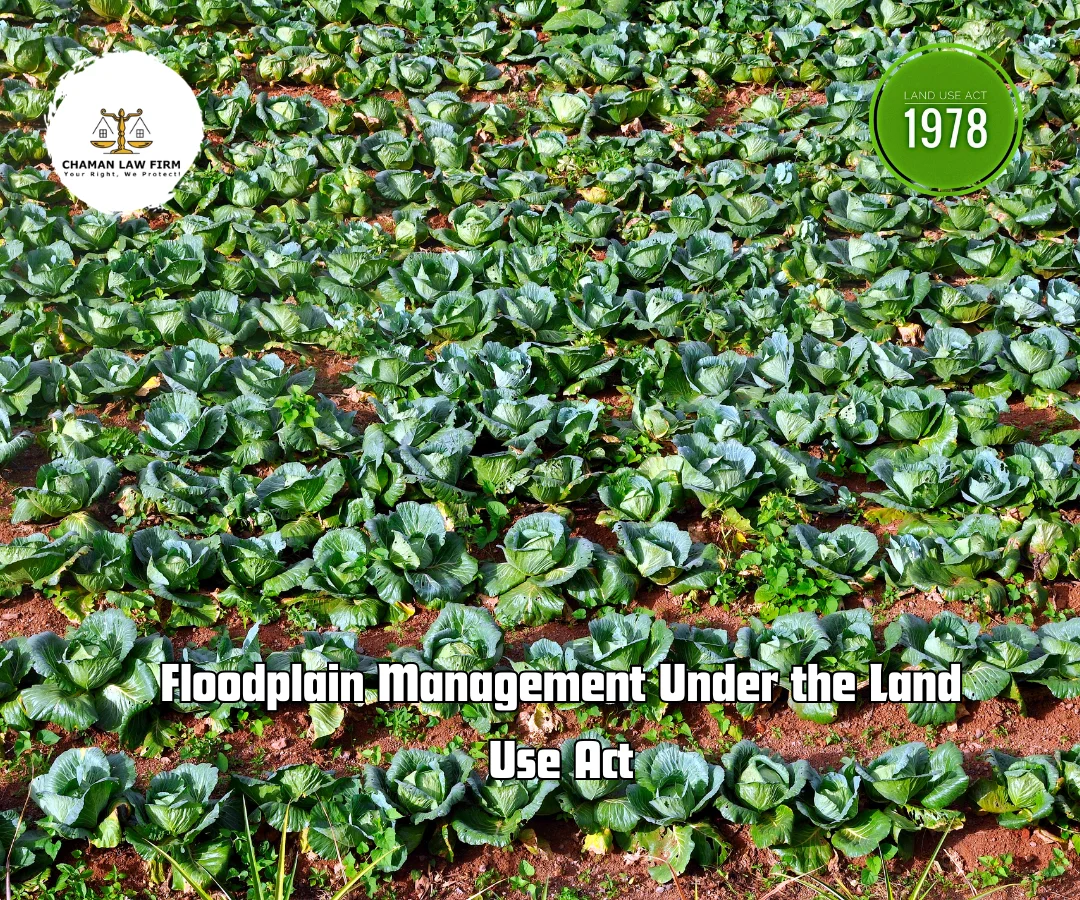Floodplain Management Under the Land Use Act in Nigeria
Introduction
Flooding remains one of the most devastating natural disasters in Nigeria, causing loss of lives, destruction of property, and environmental degradation. With climate change intensifying rainfall patterns and rising sea levels, floodplain management has become an urgent policy concern. Yet, despite its relevance, floodplain regulation in Nigeria is poorly enforced and often overlooked in land allocation and planning decisions.
The Land Use Act (LUA) of 1978, Nigeria’s central legal framework for land administration, plays a crucial role in how land is managed—including land in flood-prone zones. This article provides an in-depth analysis of floodplain management in Nigeria through the lens of the LUA, highlighting policy gaps, legal implications, challenges, and proposing effective solutions. A real-life case study is also included to illustrate the practical impact of poor floodplain governance.
1. Understanding Floodplains and Their Importance
1.1. What is a Floodplain?
A floodplain is a low-lying area adjacent to a river, lake, or coastal region that periodically becomes inundated during heavy rains or water body overflow.
1.2. Importance of Floodplains
Natural drainage and water storage
Ecosystem habitat for flora and fauna
Fertile agricultural lands
Recreation and tourism potential
1.3. Risks of Uncontrolled Development in Floodplains
Property loss and displacement
Contamination of water sources
Erosion and soil degradation
Increased flood vulnerability
2. Legal Framework for Land Management in Nigeria
2.1. The Land Use Act of 1978
The LUA vests all land in a state in the Governor, who holds it in trust for the people. It provides a unified framework for land allocation and urban planning.
Key provisions relevant to floodplain management:
Section 1: Vests land in the State Governor
Section 5: Governor can grant rights of occupancy
Section 28: Allows for revocation in public interest (e.g., flood control)
Section 34: Recognition of existing undeveloped land
3. Relationship Between the Land Use Act and Floodplain Management
3.1. Land Allocation Without Environmental Assessment
Most land allocations under the LUA do not undergo proper Environmental Impact Assessments (EIA)—which often leads to developments in flood-prone areas.
3.2. Weak Enforcement of Planning Laws
State governments, despite holding land in trust, often issue C of Os and consents without floodplain data analysis or restriction zones.
3.3. Public Interest Revocation and Flood Control
Under Section 28, land titles may be revoked for public safety and environmental protection, but this power is rarely used for flood mitigation.
4. Institutional Roles in Floodplain Management
Federal Agencies:
Nigeria Hydrological Services Agency (NIHSA) – monitors flood levels
National Emergency Management Agency (NEMA) – coordinates disaster response
Federal Ministry of Environment – oversees environmental policy
State Agencies:
Urban and regional planning authorities
State Emergency Management Agencies (SEMAs)
Environmental Protection Agencies
Gaps:
Poor coordination between land allocation offices and environmental authorities
Lack of floodplain zoning laws at state level
5. Case Study: 2022 Lokoja Flood Disaster, Kogi State
Background:
Lokoja, situated at the confluence of River Niger and River Benue, experienced severe flooding in 2022. Thousands were displaced and infrastructure destroyed.
Key Issues Identified:
Properties developed on identified floodplains without proper permits
Lack of enforcement of relocation and flood zoning policies
Inconsistent land allocation by the Ministry of Lands
Legal Implication:
Land allocated on floodplains without proper environmental consideration may attract revocation under Section 28 of the LUA. However, this was not enforced.
Outcome:
Economic loss estimated at ₦6 billion
Hundreds of landowners in litigation over compensation and relocation
Pressure on emergency shelters and social services
6. Challenges of Floodplain Management in Nigeria
6.1. Poor Mapping and Data Systems
No comprehensive Flood Risk Maps
Lack of flood hazard classification for land parcels
6.2. Weak Legal and Institutional Enforcement
LUA does not directly mandate EIA before land allocation
Fragmentation among land, environment, and disaster management agencies
6.3. Informal Settlements and Encroachment
Floodplains often targeted for unregulated low-income housing
Lack of infrastructure forces residents to build in vulnerable areas
6.4. Climate Change Pressures
Increased rainfall intensity and frequency
Sea-level rise affecting coastal areas like Lagos and Bayelsa
7. Policy and Legal Reforms Needed
7.1. Integrate Floodplain Zoning into the LUA
Amend LUA to mandate floodplain exclusion zones
Include flood risk as a statutory requirement before issuing C of O
7.2. Digitize Land and Environmental Data
Develop national floodplain GIS systems
Link flood risk data to land registry and planning authorities
7.3. Enforce EIA Before Land Allocation
Make EIAs compulsory for all land use planning in flood-prone areas
Establish penalties for non-compliance
7.4. Promote Climate-Resilient Urban Planning
Adopt green infrastructure: wetlands, buffers, retention ponds
Use flood modeling in layout approvals
8. Role of Legal Practitioners in Floodplain Management
Lawyers can:
Conduct due diligence to identify flood risks before land acquisition
Advocate for revocation where public interest is threatened
Provide advisory services to developers and investors
Represent displaced or affected communities in court
9. International Best Practices
United States:
National Flood Insurance Program (NFIP)
FEMA flood maps used in property decisions
Netherlands:
Integrated water and land management
Dikes, zoning laws, and flood risk assessments for permits
Lessons for Nigeria:
Public-private coordination
Insurance schemes for properties in flood zones
Legal consequences for violating zoning laws
10. Recommendations for Developers and Investors
Avoid acquiring or building on untitled lands in flood-prone zones
Always conduct environmental and legal due diligence
Request floodplain maps from local authorities
Consult professionals (surveyors, planners, environmental consultants)
Conclusion
Floodplain management is a critical and underutilized aspect of sustainable land administration in Nigeria. The Land Use Act, while not explicitly designed for flood control, offers pathways for environmental protection through public interest revocation, better land use planning, and integration of environmental data in allocation processes.
To protect lives, investments, and the environment, Nigeria must reform land administration systems, empower regulatory institutions, and integrate flood risk into all development decisions.
Building or Investing in Nigeria? Don’t Let Flood Risk Wash Away Your Future.
Flood-prone areas are silently costing investors billions—and much of it is preventable with the right legal guidance and title verification. Under the Land Use Act, floodplain oversight is not just environmental—it’s a legal necessity.
At Chaman Law Firm, we protect you from costly land mistakes by ensuring your property plans align with both land law and environmental risk regulations.
Our Legal Services Include:
✅ Comprehensive land search and flood risk assessment
✅ Title verification and Governor’s Consent
✅ C of O processing with environmental compliance
✅ Advisory for developers and estate planners
✅ Legal defense and litigation for land-related disputes
📞Phone: 08065553671, 08096888818
✉ Email: chamanlawfirm@gmail.com
📍 Address: 115, Obafemi Awolowo Way, Allen Junction, Ikeja, Lagos, Nigeria
🌍Click here to learn more about Chaman Law Firm
💼 Chaman Law Firm — Your Legal Shield in Real Estate, Environmental Compliance, and Land Use Management.


